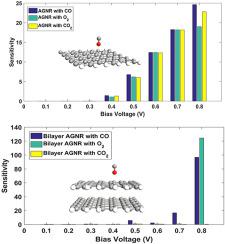Physica E: Low-dimensional Systems and Nanostructures ( IF 2.9 ) Pub Date : 2021-01-19 , DOI: 10.1016/j.physe.2021.114635 Sharieh Jamalzadeh Kheirabadi , Rahim Ghayour , Maryam Sanaee , Behnam Jooj

|
Detection and sensing of toxic gases are vital in many areas such as in environmental and safety monitoring, industrial applications and etc. Fundamental requirements for modern gas sensors typically are small size, low power consumption, high sensitivity and good selectivity towards various gases. Recently, graphene-based gas sensors have attracted significant attention due to their potential applications. Based on published works, the energy band gap of monolayer graphene nanoribbon (GNR) varies by changing its ribbon width. However, in the case of bilayer GNR, the energy band gap varies via three ways: the ribbon width, the layers separation and the symmetry between the layers. Therefore, it is interesting to investigate the characteristics of bilayer armchair graphene nanoribbon (B-AGNR) as gas nanosensor in presence of CO, O2 and CO2 gas molecules. In this study, we report a theoretical investigation and numerical simulation of the electronic properties of monolayer and bilayer AGNR (with 10 atoms in width) and study their sensitivities in presence of CO, O2 and CO2 gas molecules. Using Quantum espresso-5.3.0 package, the structure optimizations are done based on density functional theory (DFT). Moreover, we have evaluated the current-voltage (I-V) characteristics of the aforementioned structures using the open source package TRAN SIESTA which is based on non-equilibrium Green's function (NEGF) method. The obtained results show that the adsorption of CO, O2 and CO2 gas molecules onto AGNR can be modified significantly in bilayer AGNR with respect to the monolayer. These gas molecules show weak interaction with the AGNR atomic structure due to large interaction distances. Thus, it is deduced that the graphene nanoribbon (AGNR) shows weak gas sensing in presence of CO, O2 and CO2 molecules. Meanwhile, bilayer AGNR shows different electronic properties compared to monolayer AGNR which makes it highly sensitive and selective to the presence of O2 and CO gases.
中文翻译:

基于双层扶手椅石墨烯纳米带的选择性气体传感器
在许多领域中,例如在环境和安全监控,工业应用等中,有毒气体的检测和传感至关重要。现代气体传感器的基本要求通常是小尺寸,低功耗,高灵敏度和对多种气体的良好选择性。近来,基于石墨烯的气体传感器由于其潜在的应用而引起了极大的关注。根据已发表的作品,单层石墨烯纳米带(GNR)的能带隙会通过改变其带宽而变化。然而,在双层GNR的情况下,能带隙通过三种方式变化:带宽度,层分离和层之间的对称性。因此,研究存在CO,O的双层扶手椅石墨烯纳米带(B-AGNR)作为气体纳米传感器的特性非常有趣。2和CO 2气体分子。在这项研究中,我们报告了单层和双层AGNR(宽度为10个原子)的电子性质的理论研究和数值模拟,并研究了它们在存在CO,O 2和CO 2气体分子的情况下的敏感性。使用Quantum espresso-5.3.0软件包,基于密度泛函理论(DFT)对结构进行了优化。此外,我们已经使用基于非平衡格林函数(NEGF)方法的开源封装TRAN SIESTA评估了上述结构的电流-电压(IV)特性。所得结果表明,CO,O 2和CO 2的吸附相对于单层,在双层AGNR中可以大大修饰AGNR上的气体分子。由于相互作用距离大,这些气体分子与AGNR原子结构的相互作用较弱。因此,可以推断出石墨烯纳米带(AGNR)在存在CO,O 2和CO 2分子的情况下显示出弱的气体感测。同时,与单层AGNR相比,双层AGNR显示出不同的电子特性,这使其对O 2和CO气体的存在高度敏感并具有选择性。











































 京公网安备 11010802027423号
京公网安备 11010802027423号